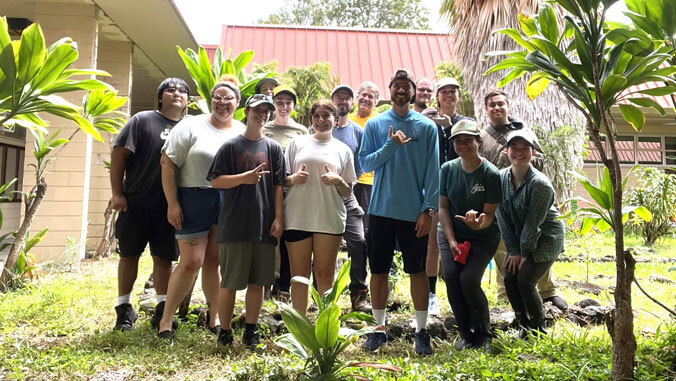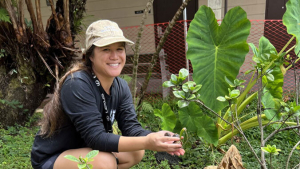
More than 30 student volunteers have begun the process of restoring and expanding the (māla) garden in the life sciences quad at University of Hawaiʻi at Hilo. The area is being transformed into a native forest māla, filled with 25 new species and planted by ambitious student leaders with the intent to bring a renewed sense of life to the garden.
Ty Shimabukuro, a marine science student from Oʻahu, donated ʻohe mauka, wiliwili, naio papa, māmane, ʻōhai, ʻōhiʻa, ʻenaʻena, alaheʻe, lama, delissea, ʻōpelu, tree ʻākia and maiapilo to the project.
“The majority of these plants only grow here, and I like growing plants, so I’m glad I found a lot of people who also enjoy meeting to learn from these kinds of shared experiences,” Shimabukuro said. “I’m happy to have skills, things and time that can be shared with the community.”
Professor of biology Patrick Hart is overseeing the project.
“It’s great to see new life and energy going into the garden,” said Hart. “For a long time, we’ve had a vision for creating a small native wet forest right here on campus where students can comfortably study surrounded by native trees. My favorite part has been seeing students be so enthusiastic about planting native plants.”
The life sciences quad is well-known for its large garden bed that features a massive endemic loulu tree planted by professor emeritus Don Hemmes. Hemmes founded and continues to maintain the campus botanical gardens that feature a large collection of bromeliads and has made himself available as a consultant to those who are transforming the quad.
Student club collaboration

A new student organization called the Creature Keeper Club is working on the project. The group’s mission is to undertake a variety of student-inclusive research programs and campus improvement projects that engage with living species. The club has more than 35 members and three primary research projects and is aiming to fund name plaques for each plant in the garden, as well as covered seating with charging stations for students who traverse the māla.
The Creature Keeper Club is in partnership with the Kaiameaola Club, a student organization based at the tropical conservation biology and environmental science graduate program. Both clubs will work together to renovate and plant the māla. The team hopes to continue shifting the garden’s focus toward native plants that can be used as an example for responsible landscaping, conservation and reforestation.
Anna Ezzy of the Kaiameaola Club said the native forest māla is important to improving biodiversity on campus and supporting native pollinators.
“Native pollinators are crucial to fostering Hawaiʻi’s biodiversity which feeds us, sustains our cultures and supports healthy air, land and water,” said Ezzy. “I hope that the native forest māla will demonstrate for visitors how to support and sustain native plant populations in their own backyards, and have an exponential effect on native pollinator habitat size throughout (the island).”
— by Jordan Hemmerly
For more information visit UH Hilo Stories.

